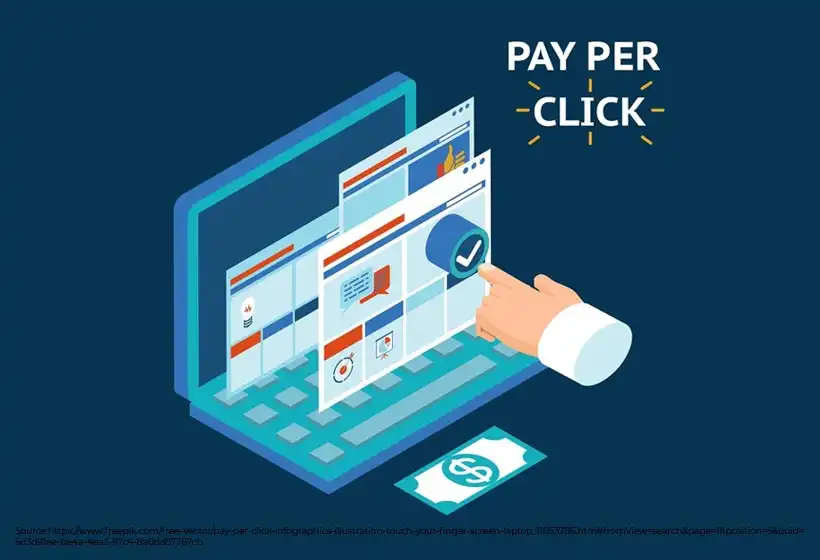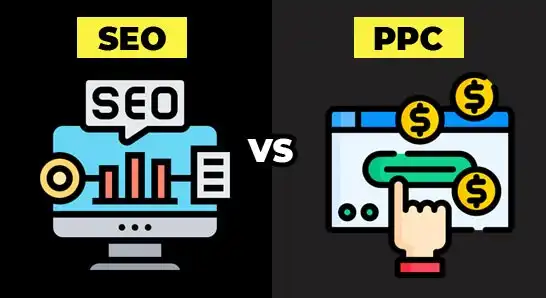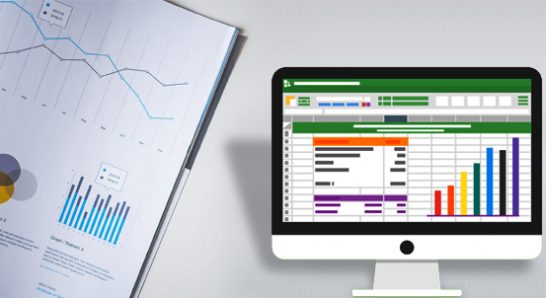Are you in the look-out to boost your online visibility, but unsure whether to focus on SEO or PPC?
It’s a common dilemma many businesses face in today’s digital landscape.
According to recent data, spending on advertisements in the Search Advertising Market in the United States is expected to reach $132.0 billion in 2024.
SEO (Search Engine Optimization) and PPC (Pay-Per-Click) are two powerful strategies for driving traffic to your website. SEO aims to improve your website’s organic ranking in search engine results, while PPC involves paying for ads to appear at the top of search engine results pages.
Here, we will explore SEO and PPC difference, their pros and cons, and why an integrated approach might be the key to maximizing your online presence.
Whether you’re aiming for long-term growth through SEO or seeking immediate results with PPC, understanding these strategies can help you make informed decisions.
Ready to delve into the world of digital marketing? Let’s get started!
SEO Or PPC: ‘What Is What’ In Marketing?
What is SEO?
SEO means making your website easier to find on search engines like Google. When your site has good SEO, it pops up more in searches that match what you offer.
Here’s how you can improve your site’s SEO:
- Use clear and helpful writing on your website.
- Explain things in simple language that’s easy to understand.
- Include words that people might use when searching for your products or services. These are called keywords.
Learn more about search engine optimization in digital marketing!
SEO includes 4 main areas:
- Keyword research: It figures out what people are searching for online.
- On-page SEO: Make content that matches what people want to find.
- Off-page SEO: Get other websites to trust and recommend your site.
- Technical SEO: Make sure search engines can easily find, read, and show your content to people.
Let us discuss in detail:
- Keyword Research
Keyword research helps to find words and phrases people type into search engines. This helps you understand what your customers are looking for online. By knowing the right keywords, you can make sure your website shows up when people search for those terms.
For example, imagine you’re running a bakery, and you want to make sure people looking for vegan treats can find you easily. You must do some research to see what words they use when searching online, like “vegan bakery near me.” Then, you update your website and create content that uses those words.
This way, when someone searches for vegan bakeries nearby, they’ll see you right at the top of the list!
- On-Page SEO
On-page SEO is the creation of content that matches what people are searching for. This involves understanding what your customers want and making sure your website provides it.
It’s about strategically placing keywords in your content, like in titles and headings, using short and descriptive URLs, and optimizing images to help search engines understand what your page is about.
- Off-Page SEO
Off-page SEO is doing things outside your website to make search engines like Google trust your site more. One big thing is getting other reputable websites to link to yours, which tells search engines that your site is trustworthy.
Reviews, citations, and mentions from other websites also play a role in boosting your site’s credibility.
- Technical SEO
Technical SEO makes sure your website is set up properly so that search engines can easily find and understand it. This involves things like optimizing your site’s structure, making sure it loads quickly, and ensuring all pages are accessible to search engine crawlers.
If search engines can’t find or understand your website, it’s unlikely to show up in search results, so technical SEO is crucial for visibility.
Now, let’s discuss what PPC means!
What Is “PPC” And When Should You Use It?
PPC marketing is like paying for your ad to show up online, and you only pay when someone clicks on it. You might see these ads when you search for something or scroll through social media.
Here’s how it works with Google Ads:
- Keyword research: Find out what words people are typing in when they’re looking for something like what you offer.
- Bid setting: You decide how much you’re willing to pay for each click on your ad.
- Ad creation: Make an ad that’s interesting and related to what people are searching for.
- Audience targeting: Choose who you want to see your ad based on factors like their interests, location, and more.
Google Ads is like a tool from Google that helps businesses get noticed online. You can think of it as paying for space to advertise your business on Google.
Here’s how it works.
You tell Google what keywords you want to show up for, and when people search for those keywords, your ad might appear. The cool part is that you only pay Google when someone clicks on your ad to visit your website or give your business a call.
Plus, you can customize your ads to target specific groups of people, like those interested in your products or services or folks in a certain area. This is handy, especially for small businesses that can’t constantly update their websites with new sales or deals.
But wait, there’s more!
With Google Ads, you can also put your ads on other websites that are part of the Google Display Network. This network includes tons of websites, so you can reach even more potential customers. You can choose where your ads show up or let Google pick for you based on who you want to reach.
It’s important to know that Google Ads won’t magically boost your website’s ranking in Google searches. It’s different from SEO, which is all about improving your website’s organic search results. Instead, Google Ads helps you get your ads in front of people who are actively looking for businesses like yours.
The Search Landscape
To make a smart choice between SEO and PPC, it’s important to grasp how Search Engine Result Pages (SERPs) look for the keywords that are relevant to your business.
In the past, search results used to be limited to just “10 blue links.” However, today’s search engines offer a variety of page features aimed at giving you thorough answers and options to explore topics in more depth.
In today’s search results, you’ll notice several key features:
- Ads: These are paid placements at the top and bottom of the page.
- Knowledge panels: Information boxes that appear for specific topics.
- Featured snippets: Concise answers to common queries.
- Maps: Location-based results, often for local businesses.
- Images and videos: Visual content relevant to your search.
- Top stories: Latest news articles related to your query.
- People Also Ask: Questions related to your search with brief answers.
- Carousels: Interactive displays of related content.
- Organic listings: Non-paid results based on relevance.
- Search tools: Options like related searches to refine your query.
- More ads: Additional sponsored content interspersed throughout.
Understanding this diverse landscape is crucial for effective search engine based marketing.
Now, let’s explore how SEO and PPC can benefit your specific needs.
SEO vs. PPC Pros and Cons
What are the differences between organic and paid listings, especially those that appear above organic results? Let’s have a look!
How Can SEO Help You Achieve Your Goals?

Pros
- Awareness: When your business appears in search results for specific keywords, it helps people discover your brand and thus drives awareness.
- Branding: Being visible for relevant search terms helps build a positive image for your brand. Customers trust businesses they find during their research.
- Credibility and trust: Appearing in organic search results boosts your credibility, as many users trust these results more than ads.
- Versatility: Organic search results offer various opportunities to showcase your business to potential clients.
- Reputation and reviews: Positive reviews in search results enhance trust in your brand.
- Website traffic: More visibility means more visitors to your website, providing opportunities to engage and inform potential customers.
- Cost per click: Unlike paid ads, organic traffic doesn’t cost per click, though it requires time and effort to build.
- Return on investment (ROI): SEO can offer better ROI compared to paid advertising as costs for clicks continue to rise.
- Cost-effectiveness: While SEO isn’t cheap, it’s generally more cost-effective than other marketing methods for building brand awareness and driving relevant traffic.
- Sustainability: Organic traffic doesn’t disappear when you stop paying, making it a sustainable option during tight budgets.
- Not paying for every click: SEO helps target users earlier in the buying process without paying for every click, especially those with low conversion rates.
- Scope: With countless daily queries, strong organic visibility maximizes your reach without paying for every click or advertising every piece of content.
- Strategic advantage: Establishing yourself in organic results provides a strategic edge over competitors who rely solely on paid advertising.
SEO offers numerous advantages, yet it presents certain challenges, too. Here’s what you should know:
Cons
- High Competition: The landscape is crowded, making it tough to stand out.
- Complex Search Results: Search pages are cluttered with various types of results, including ads.
- Big Players Dominate: Giants like Amazon and eBay often overshadow smaller businesses.
- Localized Challenges: Local results can be extremely specific, limiting your reach.
- Content Hurdles: Creating effective content can be a struggle, especially for smaller ventures.
- Link Building Complexity: Tactics like link building are hard to master due to misinformation.
- Algorithm Changes: Updates can disrupt your strategy unexpectedly.
- Misleading Information: There’s plenty of inaccurate SEO advice out there, wasting your time.
- Time Drain: It’s easy to invest effort in tasks that don’t contribute much to your success, like writing blog posts that won’t rank.
SEO tools aim to help but often overwhelm you with tasks that don’t add real value. They can be useful with experience, knowing what matters and what to ignore. Despite its challenges, SEO is valuable. It’s crucial to set achievable goals and measure progress realistically.
Pros and Cons of PPC
How do paid search and organic search differ? And if SEO brings in free traffic, why should a business think about paid search?
Let’s explore some of the benefits of PPC advertising together!
Pros
- Targeting: With PPC, you can precisely aim your ads at potential customers. You can target them based on search keywords, time of day, location, language, and more. This means your ads reach the right people at the right time, unlike organic traffic, which is less focused.
- Speed: While building organic visibility takes time, you can set up a PPC campaign quickly. Within days, your ads can be up and running, reaching customers who are ready to buy. It’s the fastest way to get noticed by potential buyers through paid search advertising.
- Position on the page: Paid search ads appear prominently at the top of search results, ensuring that users see them first, even if they scroll down the page.
- Improved ads: With PPC ads, you have control over your messaging and can include details like calls, locations, and pricing. This gives you more space to convey your marketing messages effectively.
- Dynamic ad copy: Google’s responsive search ads offer a variety of combinations to customize your ads, ensuring they attract clicks.
- Visual product ads: If you’re selling a product, visual shopping ads provided by Google can give users a clear idea of what they’ll find when they click on your ad.
- Brand visibility: Paid search ads ensure that your brand is seen by the right people, even if they search for your brand after seeing your ad.
- Budget control: With PPC, you can set a daily budget and control your spending, making it easier to manage your advertising costs.
- Agility: PPC allows for rapid testing of new products or marketing messages, providing valuable feedback quickly.
- Marketing Intelligence: Unlike organic search, PPC provides detailed keyword data, which can be analyzed to improve your overall marketing strategy.
- A/B testing: Easily compare different ad versions, landing pages, and call-to-action buttons to optimize your campaigns for better results.
- Stability: Paid search is less prone to fluctuations than organic search, and strategies like careful keyword selection and analysis can help improve ROI over time.
- Cost-effectiveness: Despite misconceptions, a well-managed PPC account can be a cost-effective way to generate leads, especially for local businesses targeting specific geographic areas and keywords. With ongoing optimization, costs can be further reduced while increasing returns.
Pay-Per-Click (PPC) advertising offers several advantages. However, it’s essential to be aware of potential drawbacks as well. Let’s discuss it!
PPC Cons
- Pay-per-click advertising can be costly.
- PPC can be very competitive, especially for popular keywords related to buying and selling.
- Running PPC campaigns requires ongoing investment. If you stop spending money, your website traffic will decrease.
- It’s relatively easy for competitors to imitate your PPC strategy.
- Starting PPC advertising is simple, but becoming proficient at it takes time and effort.
So, what should you do next?
PPC advertising on search engines is an incredibly effective marketing tool, possibly the most effective one available.
To succeed in a competitive market:
- You need to set up your campaigns correctly. This includes choosing the right keywords, crafting compelling ads, creating landing pages that convert, and tracking your results using analytics.
- It’s common to find yourself in bidding wars with other advertisers, which can drive up your costs. When you run PPC ads, you’re essentially competing for attention with other advertisers. This competition can lead to increased costs if not managed properly.
- Effective PPC management involves constant monitoring and optimization. This includes adjusting bids, improving Quality Scores, optimizing ad positions, and increasing click-through rates.
Learn more on PPC! - While some of this can be automated with scripts, it’s important to have an experienced professional oversee your PPC campaigns to ensure they perform at their best.
- PPC advertising is a powerful tool, but it’s essential to optimize every aspect of your campaigns to achieve maximum results without overspending.
Now that you understand the advantages and disadvantages of both SEO and PPC, you can make informed decisions about your marketing strategy. The next step is to stay updated on the latest developments in both SEO and PPC to maintain your competitive edge.
Understanding Google Core Updates and Their Impact on SEO
Google Updates are significant events for website owners and those in the field of search engine optimization (SEO). These updates involve changes to Google’s algorithms, filters, data refreshes, or other adjustments. Often, when a website’s ranking or SEO Visibility drops, these updates are the reason.
The main goal of any update is to enhance the relevance and quality of search results. Most changes target specific features, such as improving spam detection or addressing duplicate content issues.
How often does Google update its algorithms?
Google is always working to make sure their search results work well for you. They are constantly updating search algorithms, the formulas that decide which websites show up when you search for something. It makes about 500 to 600 changes to these algorithms every year.
These changes can be small tweaks or big shifts that affect how search results are ranked. Sometimes, Google releases major updates called broad core algorithm updates. These happen every year and can have a noticeable impact on how search results are shown.
Google tries to keep you informed about the major updates it makes. However, many smaller changes happen each month, and you might not even notice them unless you see changes in your website’s traffic, like sudden increases or decreases.
According to recent data, in 2022 alone, Google ran over 800,000 experiments to improve search. These experiments led to more than 4,000 changes that make search smarter and more helpful for you. These improvements include things like making search understand natural language better and using advanced AI and machine learning techniques.
For marketers, it’s crucial to keep up with these changes. By staying informed about the latest updates to algorithms, you can make sure your website meets requirements and stays visible to potential customers.
Knowing when there are changes in search results can also be useful for understanding how your website is performing.
Let’s take a closer look at the Google Algorithm Updates from 2023!
2023 Google Algorithm Changes: What You Need to Know
In 2023, Google introduced several updates to its search algorithm, making it a year of significant changes. Let’s talk about some important updates!
Review Update
It focuses on promoting top-notch reviews that provide valuable insights and original research. These reviews should be written by experts or passionate individuals. The algorithm assesses content at the page level, particularly articles, blog posts, or similar standalone pieces that offer recommendations, opinions, or analysis.
It encourages website owners to visit Google’s help page for guidance on creating high-quality reviews.
Your content should aim to:
- Demonstrate expertise
- Present supporting evidence
- Thoroughly examine both the pros and cons of the topic
The goal is to empower users with comprehensive information that helps them make informed decisions based on a deep understanding of the subject. Improving your content quality can positively impact your search ranking over time, though it’s just one of the many factors influencing ranking.
Core Update
On November 2, 2023, Google rolled out a major update to its search algorithm. This update aims to make search results more helpful and reliable for users. It might influence the traffic to your website.
In the latest update, Google recommends putting your efforts into providing top-notch content. The algorithms are designed to recognize and reward quality content. Additionally, it’s a good idea to review any decreases in your site’s performance.
Take a close look at which pages were most affected and what kinds of searches were impacted. This will help you understand how these pages measure up against our quality standards.
Google provides some extra tips here to understand how these updates might affect your site.
Helpful Content Update
On September 14, 2023, Google released an update called helpful content update. This update was all about making their system better at finding content that people find useful. The goal is to give a boost to content that visitors like and find helpful and not give as much attention to content that doesn’t meet their expectations.
If you’re making content that people find helpful, you don’t need to worry. In fact, this update could be good news for your website because it’s meant to give a thumbs up to helpful content.
But if you’ve seen a change in your website’s traffic and you think it might be because of this update, it’s a good idea to take a look at your content. Check if there’s anything that doesn’t seem very helpful and either fix it up or take it down.
Besides that, Google has also made some updates to the paid search industry. Let’s take a closer look at them!
What’s new in PPC?

Here are the latest updates in the world of online advertising to keep you informed:
- Google has added new lead form extensions to Google Ads, making it easier for you to capture leads directly from your ads.
- Google Analytics 4 now features a new audience report, providing valuable insights into your website visitors and their behaviors.
- Google Ads is discontinuing enhanced CPC (Cost-per-click) for shopping campaigns, so it’s time to explore other bidding strategies for better results.
- Google is inviting users to join the beta for its innovative “Demand Gen” campaigns, offering new opportunities to generate leads and drive sales.
Hence, we’ve seen some positive changes in PPC campaigns and Search Engine Results Pages (SERP). While we can’t predict what Google has in store for us next year, one thing’s for sure: change is inevitable. But don’t worry; Google has you covered with useful tips and resources to help you thrive despite the uncertainties.
SEO vs. PPC: Which Is Better?
Neither SEO (Search Engine Optimization) nor PPC (Pay-Per-Click advertising) is better or worse than the other. Both methods are valid for generating website traffic.
The truth is the effectiveness of each method varies depending on the circumstances. Certain situations may call for one channel over the other.
Let’s take a look!
- You’ve got a unique product that’s breaking new ground
To attract more visitors naturally, it’s important to focus on topics that people are already interested in. However, if you’re introducing something completely new and disruptive, chances are people aren’t actively searching for it yet.
In such cases, it might be more effective to use social media PPC to spread the word and get people talking about your product.
- You are getting ready to launch a new product or have a special one-time event
SEO typically requires some time to show results, and your event might be finished before your website ranks well in search engines.
In this situation, you might want to think about using PPC (pay-per-click advertising) or exploring other marketing avenues, such as influencer partnerships. These methods can help you reach your audience more quickly and effectively.
- You are Promoting content
In most cases, people prefer to share content that isn’t purely promotional, such as landing pages or product pages.
To improve the visibility of these pages in search results, you might want to explore SEO methods. Alternatively, if you’re looking for faster results, you could consider using PPC (pay-per-click) advertising, which allows you to direct traffic straight to your landing page.
- You have a Low Budget
It may happen that you have a limited or no budget available. If this is the scenario, focus on Search Engine Optimization (SEO) and content marketing strategies to boost your brand visibility and attract visitors to our website.
SEO and PPC: The Power of Both Worlds
Top-performing businesses leverage both SEO and PPC because they work together effectively.
If both methods are successful, why not use them both?
Here’s 3 tips on how you can combine them.
- Tip 1: Utilize PPC ads to boost your content: Every piece of content you create demands significant time and effort, typically 10–20 hours. To ensure it reaches its intended audience, employ PPC ads to expand its reach to as many interested individuals as possible.
- Tip 2: Implement retargeting: Retargeting enables you to reconnect with visitors who have previously visited your website. This presents an opportunity to encourage them to revisit and reconsider making a purchase.
- Tip 3: Target keywords your competitors are bidding on: Imagine having insight into the keywords your competitors are targeting in Google Ads. This knowledge could help you identify valuable keywords to pursue through PPC or SEO strategies.
Which option is more effective: SEO or PPC ads? Is it worth investing in? Read more!
Should I Invest in SEO or PPC?
When deciding between SEO (Search Engine Optimization) and PPC (Pay-Per-Click) ads, it really depends on what you’re aiming to achieve for your business.
SEO is all about making sure your website appears prominently in search engine results. It’s a crucial part of online marketing because it helps your business get noticed, even though it might take some time to fine-tune the process.
On the other hand, PPC ads offer a more immediate way to connect with customers. With PPC, you can tailor your advertising campaign quickly and directly target your audience.
If your main goal is to drive traffic to your website right away, PPC ads might be the better choice. But if you’re looking to build a strong online presence for the long term, then focusing on SEO is the way to go.
Of course, you can also consider a combination of both SEO and PPC to cover all bases and create a comprehensive marketing strategy for your business.
Synopsis
SEO or PPC: Making the Choice That Counts!
In the dynamic realm of digital marketing, businesses are often faced with the decision between two potent strategies: Search Engine Optimization (SEO) and Pay-Per-Click (PPC) advertising. But determining which one can be a challenge!
This article aims to shed light on the matter by exploring the pros and cons of both SEO and PPC, considering various factors. Recent updates to Google’s algorithms impacting both SEO and PPC are also highlighted.
Ultimately, the goal is to assist you in optimizing your online presence by combining the strengths of SEO and PPC. A hybrid approach may prove to be the most effective, allowing businesses to leverage the unique advantages of each strategy to accomplish their marketing objectives.
FAQs on SEO vs. PPC
Q1. Is PPC or SEO more effective?
- If you’re looking for a lasting and effective strategy, consider using SEO. It helps improve your online presence over time. But if you’re aiming for quick results, pay-per-click marketing might be more suitable. Remember, you can combine both approaches for a comprehensive digital marketing strategy.
Q2. Does PPC increase SEO ranking?
- PPC ads, or pay-per-click ads, don’t directly impact your website’s organic rankings in search engine results. So, if you notice your competitor spending more on Google Ads and getting better results, it’s not because their ads are influencing their organic search ranking.
Q3. Which is harder, SEO or PPC?
- PPC advertising is known for its ease of use and ability to deliver fast, reliable outcomes. But it can be pricier, and its success hinges on how well you manage your campaigns. On the flip side, SEO takes longer to see results and demands consistent effort and dedication.
- How Long Does SEO Take To Start Working? Read on!
Q4. Is SEO cheaper than PPC?
- Although SEO campaigns may not be the cheapest option, they offer better value compared to PPC. With SEO, you invest upfront for long-term results without having to pay for each click.
References
- Goyal, A., Bhong, S., Kumbhare, P. and Bharadkar, R., 2021. The new era of digital marketing: a literature review. PalArch’s Journal of Archaeology of Egypt/Egyptology, 18(10), pp.728-741.
Link: https://archives.palarch.nl/index.php/jae/article/view/9890
- Das, S., 2021. Search engine optimization and marketing: A recipe for success in digital marketing. CRC press.
Link: http://surl.li/qwdua
- Denga, E.M., Vajjhala, N.R. and Rakshit, S., 2022. The Role of Digital Marketing in Achieving Sustainable Competitive Advantage. Digital Transformation and Internationalization Strategies in Organizations, pp.44-60.






